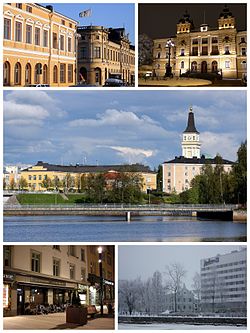Oulu
Uleåborg (Swedish) | |
|---|---|
City | |
| Oulun kaupunki Uleåborgs stad City of Oulu | |
 From top, left to right: Rantakatu in downtown Oulu; Oulu City Hall; Lyseo Upper Secondary School and the Oulu Cathedral; Shops along Kirkkokatu; Radisson Blu Hotel along Ojakatu | |
| Nickname(s): | |
 Location of Oulu in Finland | |
| Coordinates: 65°00′51″N 25°28′19″E / 65.01417°N 25.47194°E | |
| Country | Finland |
| Region | |
| Sub-region | Oulu |
| Charter | 1605-04-08 |
| Government | |
| • City manager | Ari Alatossava |
| Area (2018-01-01)[3] | |
• City | 3,817.52 km2 (1,473.95 sq mi) |
| • Land | 2,972.44 km2 (1,147.67 sq mi) |
| • Water | 103.2 km2 (39.8 sq mi) |
| • Urban | 187.1 km2 (72.2 sq mi) |
| • Rank | 17th largest in Finland |
| Population (2024-10-31)[5] | |
• City | 216,174 |
| • Rank | 5th largest in Finland |
| • Density | 72.73/km2 (188.4/sq mi) |
| • Urban | 208 939[4] |
| • Urban density | 915.8/km2 (2,372/sq mi) |
| Demonym | oululainen (Finnish) |
| Population by native language | |
| • Finnish | 93.7% (official) |
| • Swedish | 0.2% |
| • Sami | 0.1% |
| • Others | 6% |
| Population by age | |
| • 0 to 14 | 17.4% |
| • 15 to 64 | 66% |
| • 65 or older | 16.6% |
| Time zone | UTC+02:00 (EET) |
| • Summer (DST) | UTC+03:00 (EEST) |
| Website | www |
Oulu (/ˈoʊluː/ OH-loo,[9][10] Finnish: [ˈou̯lu] ; Swedish: Uleåborg [ʉːlɛɔˈbɔrj] ) is a city in Finland and the regional capital of North Ostrobothnia. It is located on the northwestern coast of the country at the mouth of the River Oulu. The population of Oulu is approximately 216,000, while the sub-region has a population of approximately 264,000. It is the 5th most populous municipality in Finland, and the fourth most populous urban area in the country. Oulu is also the most populous city in Northern Finland.
Oulu's neighbouring municipalities are: Hailuoto, Ii, Kempele, Liminka, Lumijoki, Muhos, Pudasjärvi, Tyrnävä and Utajärvi. Oulu is the third northernmost city in the world with a population of over 100,000, after Murmansk and Norilsk in Russia.
Due to its large population and geopolitical, economic and cultural-historical position, Oulu has been called the "capital of Northern Finland".[1] Oulu is also considered one of Europe's "living labs", where residents experiment with new technologies (such as NFC tags and ubi-screens) on a community-wide scale.[11] Although only in the top 2% of universities,[12] the University of Oulu is regionally renowned in the field of information technology.[13][14][15] Oulu has also been very successful in recent city image surveys; in a study published by the Finnish Economic Survey in 2008, Oulu received the best image rating among large cities in the country, including ratings from respondents in all provinces.[16] In the 2023 T-Media survey, Oulu was tied with Kuopio as the second most attractive city in Finland, while Tampere was ranked first.[17]
Once known for wood tar and salmon,[18] Oulu has become a major high-tech centre, particularly in IT and wellness technology.[19] Other important industries include wood processing, chemicals, pharmaceuticals, paper and steel.[20]
Oulu has been selected as the European Capital of Culture for 2026.[21][22]
- ^ a b "Discover Oulu". Finland Convention Bureau. Retrieved 14 March 2024.
- ^ Oulu – Capital of Northern Scandinavia
- ^ "Area of Finnish Municipalities 1.1.2018" (PDF). National Land Survey of Finland. Retrieved 30 January 2018.
- ^ Tarkoma, Jari (2008-01-15). "Taajamissa asuu 84 prosenttia väestöstä". Tiedote (in Finnish). Statistics Finland (Tilastokeskus). Retrieved 11 February 2013.
- ^ "Finland's preliminary population figure was 5,635,560 at the end of October 2024". Population structure. Statistics Finland. 2024-11-19. ISSN 1797-5395. Retrieved 2024-11-22.
- ^ "Population growth biggest in nearly 70 years". Population structure. Statistics Finland. 2024-04-26. ISSN 1797-5395. Retrieved 2024-04-29.
- ^ "Population according to age (1-year) and sex by area and the regional division of each statistical reference year, 2003–2020". StatFin. Statistics Finland. Retrieved 2 May 2021.
- ^ a b "Luettelo kuntien ja seurakuntien tuloveroprosenteista vuonna 2023". Tax Administration of Finland. 14 November 2022. Retrieved 7 May 2023.
- ^ "Oulu". The American Heritage Dictionary of the English Language (5th ed.). HarperCollins. Retrieved 10 May 2019.
- ^ "Oulu". Merriam-Webster.com Dictionary. Merriam-Webster. Retrieved 10 May 2019.
- ^ Saylor, Michael (2012). The Mobile Wave: How Mobile Intelligence Will Change Everything. Perseus Books/Vanguard Press. p. 63. ISBN 9781593157203.
- ^ "QS World University Rankings for Computer Science and Information Systems 2022".
- ^ Bachelor of Engineering, Information Technology – OAMK
- ^ Oulu Innovation Alliance
- ^ Tietotekniikka, Tietotekniikan tutkinto-ohjelma, tekniikan kandidaatti ja diplomi-insinööri (3v + 2v) – Opintopolku (in Finnish)
- ^ "Kuntien imagotutkimus 2007" (in Finnish). July 11, 2008. Retrieved November 13, 2020.
- ^ Hurme, Anu (29 March 2023). "Tampere listattiin jo kolmatta kertaa Suomen vetovoimaisimmaksi kaupungiksi – muista suurista kaupungeista vain Oulu paransi tulostaan" [Tampere was listed as the most attractive city in Finland for the third time – of the other big cities, only Oulu improved its result]. Yle (in Finnish). Retrieved 29 March 2023.
- ^ "Oulu: the world's tar capital". Oulu Culture Foundation. Retrieved 14 March 2024.
- ^ "What makes Oulu a high tech hub in the north?". Helsinki Times. Retrieved 14 March 2024.
- ^ "Finnish industry: Constantly adapting to a changing world". This is Finland. Retrieved 14 March 2024.
- ^ YLE: Oulu on Euroopan kulttuuripääkaupunki 2026 (in Finnish)
- ^ Oulu in Northern Finland selected as European Capital of Culture for 2026 – High North News

